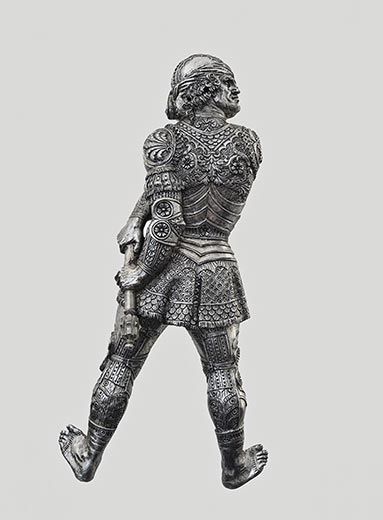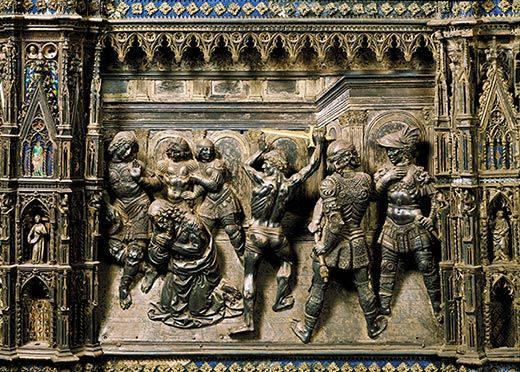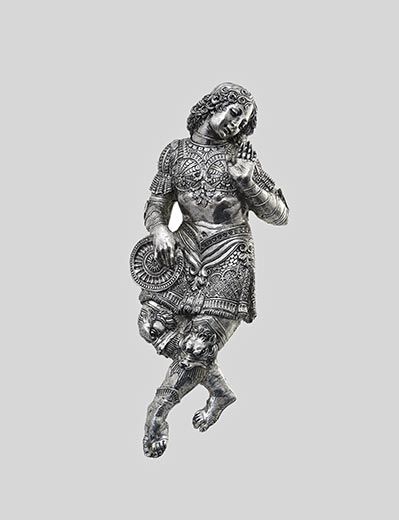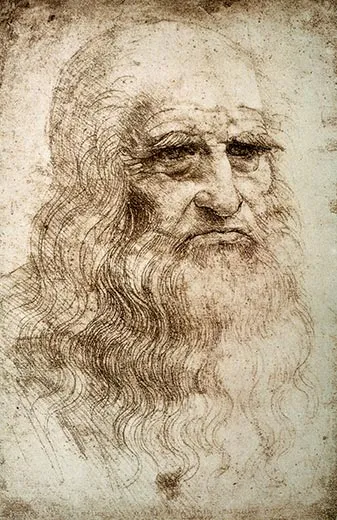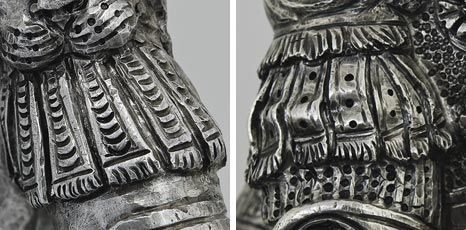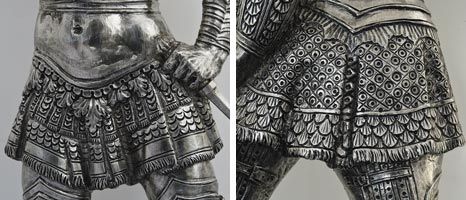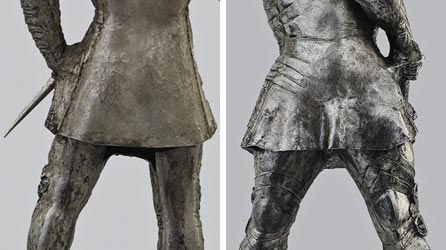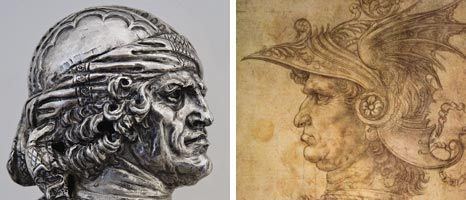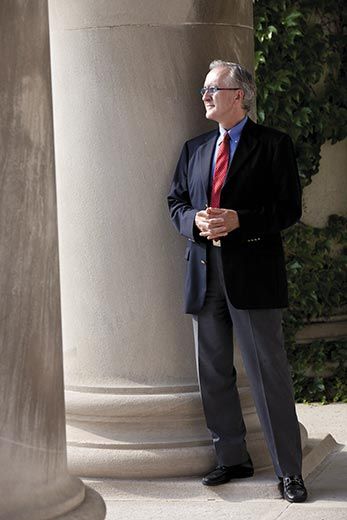Looking for Leonardo
Are figures in a Florentine altar panel attributed to Italian artist Andrea del Verrocchio actually by Leonardo da Vinci?
/https://tf-cmsv2-smithsonianmag-media.s3.amazonaws.com/filer/Beheading-of-St-John-the-Baptist-631.jpg)
There's nothing unusual about discoveries of lost works by Leonardo da Vinci. Every few months, it seems, a story hits the news that yet another "Leonardo" has been unearthed—the lost fresco of the Battle of Anghiari, a terra-cotta bust discovered in the attic of a 14th-century palazzo, or a self-portrait embedded in the spidery script of one of his notebooks. A recent television documentary even made a claim for the artist's authorship of the Shroud of Turin.
Leonardo scholar Martin Kemp, emeritus professor of art history at Oxford University, calls the perpetrators of such dubious attributions "Leonardo loonies" and says he gets "bombarded" with them almost daily.
What is exceedingly rare, however, is for a noted Renaissance scholar to bring forth evidence, patiently argued and carefully annotated, that a work previously thought to be by a lesser light is actually an effort by the young Leonardo. That is the case with Gary M. Radke's recent announcement that two silver figures, from a 12 1/8-inch by 16 1/2-inch altar panel made for the Baptistery in Florence, Italy, were more likely created by Leonardo than by his teacher, Andrea del Verrocchio.
The two figures in question, an angelic-looking youth holding a salver at the far left of the relief and a fierce, turbaned warrior, second from right, stand out from the others in the scene for their greater expressiveness and naturalistic detail—the way things move and react to the elements. Both qualities are hallmarks of Leonardo's work. Take the epaulets on the two soldiers on the right of the panel, says Radke. On Verrocchio's helmeted figure they are stiff and rigidly patterned, while on the turbaned soldier they appear to ripple as if in response to the figure's movements. Or the hair, which curls on both "Leonardo" figures according to the laws of nature instead of falling into predictable ringlets. A comparison of the reverse side of the relief's sculptures—never meant to be seen—shows the artist paying attention to how a leather skirt might fall instead of fashioning a cursory swath like Verrocchio's. (Leonardo fans can judge for themselves when the work is shown in the exhibition "Leonardo da Vinci: Hand of the Genius," curated by Radke, at Atlanta's High Museum, for four months beginning October 6.)
Radke, Dean's Professor of the Humanities at Syracuse University, had known about the panel, which depicts the beheading of John the Baptist, since an undergraduate sojourn in Florence in 1972, but it took an encounter with the recently cleaned work at an exhibition at that city's Palazzo Medici in December 2007 to provoke the "aha!" moment.
What also swayed Radke was a drawing securely attributed to Leonardo in the British Museum, the silverpoint Head of a Warrior from the mid-1470s, roughly the same date as the altar panel (1478). "It was just so spectacularly competent in terms of the medium, and every single detail was more alive and more filled with naturalistic observation than I had ever imagined from the reproduction," he says. A simple comparison of the jowls in Leonardo's drawing with those in Verrocchio's figures reveals an attention to middle-aged skin that is foreign to the teacher.
The illegitimate son of a notary, Leonardo was born in 1452 in the tiny town of Vinci, some 40 miles west of Florence. "We really don't know what his youth was like, other than he was out in the countryside," Radke says. "He must have spent a lot of time observing the world around him." According to the 16th-century biographer Giorgio Vasari, Leonardo was said to have shown an early artistic talent and, as a youth, painted a shield depicting a smoke-breathing creature made up of various animal parts put together "in so strange a fashion that it appeared altogether a monstrous and horrible thing." Radke observes that the boy probably did not get as much formal education in rural Vinci as he would have gotten in cosmopolitan Florence. Instead, he says, "Leonardo seems to have been freer to look at the world with fresh eyes. Nature was his primary teacher."
Andrea del Verrocchio was a leading sculptor, painter and goldsmith of his day. The head of a busy workshop in Florence, he is known for his bronze David. Leonardo entered Verrocchio's workshop in his teens, placed there, Radke speculates, because his father may have had connections with the Medici, the city's greatest art patrons. The young man served a long apprenticeship, at least a decade, and by the early 1480s was presenting himself to the Duke of Milan as a master of painting and sculpture as well as a formidable military engineer.
Documentary evidence suggests that Leonardo worked on many sculptural projects, even completing a 24-foot-tall clay model for a bronze horse, but none has survived. (Neither Radke nor Kemp has seen the terra-cotta bust in the palazzo in person, but both doubt the attribution. It lacks "the attention to naturalistic details I associate with Leonardo," says Radke.) The Baptistery figures, if accepted as Leonardo's, would be the only extant sculptures made in the artist's lifetime (a sculpture of a horse, thought to have been cast from a lost model after his death, is in the exhibition). Making an attribution stick when there's little with which to compare a work and when there is no paper trail—a bill of sale, preparatory sketches, a reference in a letter—is not easy.
Renaissance studies are littered with bad judgments and outright scandal. Attributions by the scholar Bernard Berenson, who died in 1959, have been overturned (and there have been allegations that Berenson colluded with art dealers for his own profit). In 1987, Frederick Hartt, an authority on Renaissance sculpture at the University of Virginia, pronounced as genuine a small plaster study for Michelangelo's David in which, it turned out, he had a financial interest. Few scholars have seen the statue, which is in a bank vault until litigation is resolved, and the attribution remains in limbo. In 1995, New York University art historian Kathleen Weil-Garris Brandt announced she had discovered a marble statue by the youthful Michelangelo, hidden in plain sight at the French Embassy's cultural offices in New York City. Several experts quickly repudiated the claim and current opinion remains divided. (Young Archer, as the statue is known, will go on exhibition in November as an object lesson in the challenge of attribution, at the Metropolitan Museum of Art in Manhattan.)
Aware of such controversies, Radke has proceeded with careful deliberation. In October 2008, he presented his thesis about the silver figures to colleagues at the Provo/Athens Renaissance Sculpture Conference, a quadrennial meeting of experts. Some were convinced, some not. "My main hesitation is to attach big names to works of art about which we know very little in terms of how the workshops in which they were produced functioned," says Sally Cornelison, associate professor of Italian Renaissance art at the University of Kansas. "I'm not going to say that it's not Leonardo, but I think we need to be cautious. We don't know that much about people who worked as goldsmiths and silversmiths during the Renaissance. It could just as easily be by an extremely capable but unknown artisan."
Martin Kemp, who did not attend the conference, is inclined to accept Radke's attribution on the basis of photographic evidence and the way the two "Leonardo" figures reflect light. Leonardo's handling of light was always more "painterly" and sensitive to the nuances of surface, he says, while Verrocchio tended toward the blunt and the sculptural. "What is absolutely right is that there are different hands and eyes at work in that panel," Kemp adds, but he speculates they might be Verrocchio's in the "Leonardo" figures and a lesser assistant elsewhere. Or was there another apprentice as talented as the young Leonardo?
As Radke himself notes, no contemporary attributions to a Leonardo sculpture have won unqualified acceptance. "I believe that until we discover some new written documents or other evidence, neither will the two figures in the silver altar," he says. "But what can one expect in a situation where no documented work has survived? That said, I do believe that there is more visual evidence for my attribution than any previously proposed."
Ann Landi is a contributing editor of ARTnews and the author of the Schirmer Encyclopedia of Art. She is based in New York.
